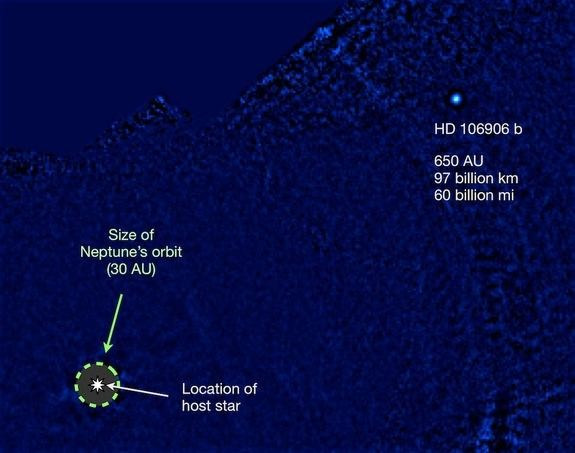Mysterious Alien Planet in Farthest-ever Orbit Discovered

Astronomers have discovered a planet 11 times the size of Jupiter revolving around its host star in the farthest-ever orbit observed so far among all the planetary systems known.
Amazingly, the planet dubbed, HD 106906 b, is about 650 AU away from its host star, HD 106906 A. AU stands for Astronomical Units or the average distance between earth and sun. This is a massive distance, by solar standards.
In our planetary system, Neptune and Uranus are the farthest large planets. The newly discovered planet is about 20 times more distant from its host star than Neptune is from the sun.
What is more baffling about this planet is that it is not cold unlike all the other planets that are distant from their parent stars. The surface temperature of HD 106906 b is about 1,500C, much hotter than even the Earth's core, and loosely comparable to the solar temperature of about 5,500C. HD 106906 b is glowing from the residual heat of its formation, researchers told Fox News.
The planet is also quite young as it was formed just 13 million years ago, compared to Earth's 4.5 billion years old.
The planetary system appears to be relatively new as leftover material from the planet and star can still be detected.
The one-of-a-kind planet was spotted by a team led by Vanessa Bailey, a fifth-year graduate student from the University of Arizona.
Astronomers Puzzled
The discovery has puzzled astronomers while raising new questions about how such large planets are formed so far away from the host star.
"This system is especially fascinating because no model of either planet or star formation fully explains what we see," Bailey said.
According to commonly accepted theories, planets that orbit close to their host star, such as earth are formed by compression of leftover clumps of massive primordial disks of gas and dust that have collapsed and compressed into a star.
But the process is too slow to explain how giant planets far away from their star are formed, the student said.
An alternative hypothesis suggests that distant giant planets may form in ways similar to mini-binary star systems.
"A binary star system can be formed when two adjacent clumps of gas collapse more or less independently to form stars, and these stars are close enough to each other to exert a mutual gravitation attraction and bind them together in an orbit," Bailey explained.
However, the difference between the masses of two stars in a binary system is typically less than 10 to 1.
"In our case, the mass ratio is more than 100-to-1," she said.
She added: "This extreme mass ratio is not predicted from binary star formation theories - just like planet formation theory predicts that we cannot form planets so far from the host star."
In the HD 106906 system, the star and planet may have collapsed independently, but the materials that clumped together to form the planet were insufficient for it to grow large enough to ignite into a new star, Bailey clarified.
The mysterious planet was discovered using the Magellan Adaptive Optics (MagAO) system and a Clio2 thermal infrared camera mounted on the Magellan telescope in Atacama Desert, Chile.
"Systems like this one, where we have additional information about the environment in which the planet resides, have the potential to help us disentangle the various formation models," Bailey said.
Besides, she said: "Future observations of the planet's orbital motion and the primary star's debris disk may help answer that question."
"Every new directly detected planet pushes our understanding of how and where planets can form," said co-investigator Tiffany Meshkat, a graduate student at Leiden Observatory in the Netherlands.
"Discoveries like HD 106906 b provide us with a deeper understanding of the diversity of other planetary systems."

© Copyright IBTimes 2025. All rights reserved.





















